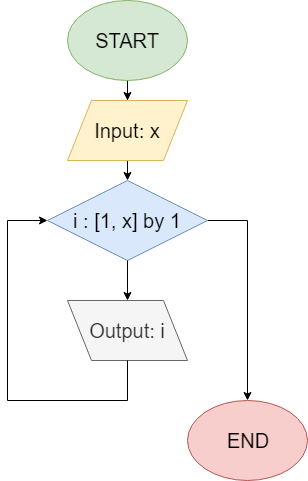The syntax for a For loop in Java is a bit complex, and has many different parts. Here’s the general format:
for(<initializers>; <loop condition>; <updaters>){
<loop code block>
}Let’s break this syntax down into each individual part to understand how it works.
First, the <initializers> section is used to create and initialize any variables that we’d like to use as loop counters inside of the loop. For example, we could use int i = 0 in that section to create a single integer variable i and set its initial value to 0. We may also declare multiple variables of the same type, separating each with a comma or ,. In that instance, we could say int i = 0, j = 1, which would declare two new integer variables, i and j, and set their values to 0 and 1, respectively. Finally, we can choose to leave that section blank, as it is not required at all. In either case, we must end that section with a semicolon ; before moving on to the next section. This section is executed just once, before the first iteration of the loop itself. We’ll explore a full example below.
The <loop condition> section is the same as in a While loop. It must evaluate to a single Boolean value, either true or false, which is used to determine if the loop continues executing or not. This section must also end with a semicolon ;, and is generally required in a For loop.
Finally, the <updaters> section can include one or more statements used to increment (update) the values of the loop counter variables. This section is executed at the end of each iteration of the loop, before the Boolean expression is evaluated again. Generally, we would include code such as i++ or i = i + 2 in this section. Similar to the <initializers> section, multiple update statements can be included in this section, separated by a comma ,. So, we could use i++, j++ to increment the values of both i and j in the same loop.
Let’s look at an example. Here’s a flowchart from earlier in this chapter containing a For loop:
This flowchart corresponds to the following code in Java. Once again, we’ll assume x is hard-coded for now:
int x = 8;
for(int i = 1; i <= x; i++){
System.out.println(i);
}In this For loop, we can clearly see the three parts. First, we have int i = 0 as the initializer. It creates a new variable and gives it an initial value. Then, we see i <= 8 is our loop’s Boolean condition. Finally, we have i++ as the lone updater, since it updates the value of the loop counter i by incrementing it by
$ 1 $.
To understand how this For loop functions in practice, let’s look at an equivalent While loop:
int x = 8;
//initializers
int i = 1;
while(i <= x){
System.out.println(i)
//updaters
i++;
}These loops are exactly identical in terms of how the code is executed. In a For loop, the initializers are performed once at the beginning, before the loop really starts. Then, we evaluate the Boolean expression and determine if we should enter the loop and perform those operations. At the end of each loop iteration, the updaters are executed to update the values of any loop counters, before the loop repeats back to the Boolean expression.
For loops in Java have one important caveat when it comes to variable scope. As expected, any variables declared in the initializers section of a For loop may be accessed from within the For loop itself, but they may also be accessed in the Boolean expression or the updaters section as well. They cannot, however, be accessed outside of the For loop.
However, any variables declared inside the For loop cannot be accessed in either the Boolean expression or the updaters. In effect, a For loop in Java has two levels of scope, one containing the variables declared in the initializers, and another for just the code inside the loop. Generally this doesn’t pose a problem, but it is an important distinction to be aware of.
Here’s one more example of a For loop in Java, using three loop counters instead of just one:
int sum = 0;
for(int i = 0, j = 1, k = 20; i + j < k; i++, j++, k--){
sum += i + j + k;
}Notice that there are three variables initialized in the initializer, which is int i = 0, j = 1, k = 20. In addition, there are three variables updated in the updater, which is i++, j++, k--. While it is uncommon for most programmers to use multiple loop counters in a single For loop, it is important to understand how it can be done.
In Java, it is possible to have loop constructs without curly braces, just like we saw for conditional constructs in an earlier. In that case, the next line of code immediately following the while or for will be the only line repeated inside of the loop.
Consider this code for example:
int x = 0;
while(x < 5)
x++;This code is valid, and will compile and run properly. However, just like with conditional constructs, if we want to add a second line to the inside of the loop, we’ll need to remember to add curly braces for our code to work properly.
In addition, we can omit parts of a For loop, as in this example:
int x = 0;
for( ; x < 5 ; )
x++;Here, we’ve omitted both the initializers and updaters of the For loop. Those parts are considered optional, and either one can be left out. However, in this case, it may make more sense to convert this to a While loop instead.
